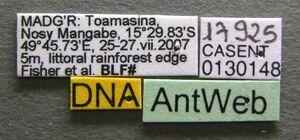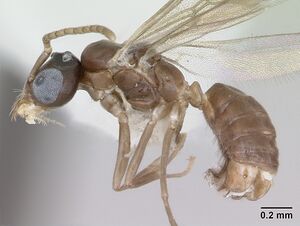Aptinoma mangabe
| Aptinoma mangabe | |
|---|---|

| |
| Scientific classification | |
| Kingdom: | Animalia |
| Phylum: | Arthropoda |
| Class: | Insecta |
| Order: | Hymenoptera |
| Family: | Formicidae |
| Subfamily: | Dolichoderinae |
| Tribe: | Tapinomini |
| Genus: | Aptinoma |
| Species: | A. mangabe |
| Binomial name | |
| Aptinoma mangabe Fisher, 2009 | |
Specimens were collected from dead twigs or vines, or foraging in the canopy. Males were collected in colonies in April and July. The only queen collected was an ergatoid. (Fisher 2009)
| At a Glance | • Ergatoid queen |
Identification
- In profile, metanotal groove distinct and set in shallow V-shaped impression. Propodeal dorsum more or less convex, meeting steeply sloped declivity in blunt, narrowly rounded curve. In dorsal view, lateral margin of pronotum evenly convex, without blunt angle at widest point. Body light to dark brown . . . . Aptinoma antongil
- In profile, metanotal groove not set in a V-shaped impression. Propodeum in absolute profile without differentiated dorsal and declivitous surfaces, forming single evenly rounded surface. In dorsal view, lateral margin of pronotum with blunt angle at widest point. Body yellow to orange . . . . . Aptinoma mangabe
A. mangabe can be separated from A. antongil by color and shape of propodeum and metanotal groove as outlined in the key above. (Differences in minor workers are discussed under antongil).
Distribution
Distribution is limited to forests around Antongil Bay including the island of Nosy Mangabe and the adjacent forest of the Masoala Peninsula.
Latitudinal Distribution Pattern
Latitudinal Range: -15.4973° to -15.73°.
| North Temperate |
North Subtropical |
Tropical | South Subtropical |
South Temperate |
- Source: AntMaps
Distribution based on Regional Taxon Lists
Malagasy Region: Madagascar (type locality).
Distribution based on AntMaps
Distribution based on AntWeb specimens
Check data from AntWeb
Countries Occupied
| Number of countries occupied by this species based on AntWiki Regional Taxon Lists. In general, fewer countries occupied indicates a narrower range, while more countries indicates a more widespread species. |

|
Estimated Abundance
| Relative abundance based on number of AntMaps records per species (this species within the purple bar). Fewer records (to the left) indicates a less abundant/encountered species while more records (to the right) indicates more abundant/encountered species. |

|
Biology
Castes
Worker
Images from AntWeb
    
| |
| Holotype of Aptinoma mangabe. Worker. Specimen code casent0130146. Photographer April Nobile, uploaded by California Academy of Sciences. | Owned by CAS, San Francisco, CA, USA. |
    
| |
| Worker. Specimen code casent0130148. Photographer April Nobile, uploaded by California Academy of Sciences. | Owned by CAS, San Francisco, CA, USA. |
Male
Images from AntWeb
      
| |
| Male (alate). Specimen code casent0173594. Photographer April Nobile, uploaded by California Academy of Sciences. | Owned by CAS, San Francisco, CA, USA. |
Nomenclature
The following information is derived from Barry Bolton's Online Catalogue of the Ants of the World.
- mangabe. Aptinoma mangabe Fisher, 2009: 40, figs. 3-5, 7a (w.q.m.) MADAGASCAR.
- Type-material: holotype major worker, 1 paratype major worker, 1 paratype minor worker, 1 paratype ergatoid queen, 1 paratype male.
- Type-locality: holotype Madagascar: Prov. Toamasina, Nosy Mangabe, 7.43 km. S Maroantsetra, 15.4973°S, 49.76223°E, 5 m., 27.vii.2007, BLF17925 (J.J. Rafanomezantsoa); paratypes with same data.
- Type-depositories: CASC (holotype); BMNH, CASC, MCZC (paratypes).
- Distribution: Madagascar.
Unless otherwise noted the text for the remainder of this section is reported from the publication that includes the original description.
Description
Worker
Major measurements: maximum and minimum based on all specimens, n=5, HL 0.54–0.57 , HW 0.53–0.56, CI 99–102, ED 0.10–0.11, SL 0.39–0.41, SI 70–75, WL 0.57–0.64, FL 0.47–0.49, PW 0.34–0.37.
Minor measurements: maximum and minimum based on all specimens, n=5, HL 0.42–0.46 , HW 0.37–0.42, CI 86–96, ED 0.09, SL 0.38–0.41, SI 97–103, WL 0.48–0.54, FL 0.41–0.45, PW 0.22–0.29.
With characters described in the genus diagnosis for major and minor workers: Apical teeth on mandible followed by 4–6 denticles; basal margin with minute, serrate teeth. Anterior clypeal margin with distinct shallow median impression; medial clypeal margin with three pairs of setae arched anteriorly over mandibles; additional pair of setae on clypeus, posterior of clypeal margin, directed anterodorsally. Scape surpassing posterior margin of head in full-face view in minors, not surpassing margin in majors. In dorsal view, lateral margin of pronotum with blunt angle at widest point. Metanotal groove in profile not impressed; propodeum in profile with dorsal and declivitous surfaces not differentiated, forming single evenly rounded surface without trace of angle at junction with declivity. Body yellow to orange.
Queen
(ergatoid) measurements: n=1. HL 0.61, HW 0.59, CI 97, ED 0.15, SL 0.44, SI 75, WL 0.82, FL 0.57, PW 0.44.
All main morphological characters of the major worker are duplicated in the queen caste. In the ergatoid queen, ocelli are present and the mesoscutellum is distinct. Metanotum indistinguishable, but metanotal groove distinctly wider than that of workers.
Male
Measurements: maximum and minimum based on n=3: HL 0.40–0.43, HW 0.54–0.57, CI 127–137, ED 0.22–0.25, SL 0.21, SI 37–39, WL 0.74–0.78, FL 0.52–0.55.
In profile, inner margin of eye convex, not flat. Antenna with 13 articles. Scape not reaching posterior margin of head, shorter than flagellar segments 1+2+3. Pedicel conical. First flagellar article cylindrical, straight, articles 1 and 2 twice as long as broad. Anteromedial clypeal margin with central concavity. Anterior clypeal margin with several pairs of straight setae projecting anteriorly, central pair longer than the setae at lateral margins. Just posterior to anterior margin, a single pair of suberect setae projecting anterodorsally. Posterior clypeal margin convex between antennal socket cavities. Palpal formula 6:3 (not confirmed with dissection). Mandible with apical tooth followed by a series of 15 or more minute denticles that decrease in size towards the basal margin. An uninterrupted curve between masticatory and basal margins. Propodeal angle indistinct; declivitous and dorsal faces of propodeum forming a single convexity. Petiole in profile with distinct scale, angled dorsally and strongly inclined anteriorly with anterior margin shorter than posterior margin. Venter of petiole with weakly developed lobe. Pygostyles present.
Type Material
Holotype: major worker, Madagascar, Province Toamasina, Nosy Mangabe, 7.43 km S Maroantsetra, 15.4973°S, 49.76223°E, 5 m. 27 July 2007, ex dead twig above ground, littoral rainforest edge (coll. J.J. Rafanomezantsoa.) collection code: BLF17925, pin code: CASENT0130146 (California Academy of Sciences). Paratypes: 1 minor worker, 1 major worker, ergatoid queen, male with same data as holotype but pins coded CASENT0130148, CASENT0192285, CASENT0175008, CASENT0130147, respectively (The Natural History Museum, CASC, Museum of Comparative Zoology).
References
- Fisher, B.L. 2009. Two new dolichoderine ant genera from Madagascar: Aptinoma gen. n. and Ravavy gen. n. Zootaxa 2118: 37-52. PDF
References based on Global Ant Biodiversity Informatics
- Fisher B. L. 2009. Two new dolichoderine ant genera from Madagascar: Aptinoma gen. n. and Ravavy gen. n. (Hymenoptera: Formicidae). Zootaxa 2118: 37-52.

